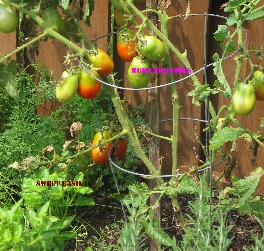 Having been raised in half an Italian-American household, I’ve had my share of tomato sauce over the years. It probably makes up a significant portion of my bloodstream at this point. As I’ve turned away from eating starchy carbs which includes all the good stuff that Italians hold so dear such as pasta, pizza, and lots of bread with butter, I’ve had to find alternative uses for marinara sauce.
Having been raised in half an Italian-American household, I’ve had my share of tomato sauce over the years. It probably makes up a significant portion of my bloodstream at this point. As I’ve turned away from eating starchy carbs which includes all the good stuff that Italians hold so dear such as pasta, pizza, and lots of bread with butter, I’ve had to find alternative uses for marinara sauce.
But don’t worry, I’ve found that you can have your marinara sauce and enjoy it too without the heavy starch load that typically accompanies it. For now, I’d like to share an old family recipe for homemade marinara sauce. In future posts I’ll share some unique ways of using it in some new twists on traditional recipes.
Being that it’s the height of backyard tomato growing season where we live, it’s a perfect time to show you step-by-step how to make marinara sauce completely from scratch. It involves a bit of extra work, but it’s well worth it in terms of freshness, flavor, and texture. I’m also including two variations on the recipe so that you can make quicker versions in just a few minutes. No matter which version you choose to go with, it will be light years better than anything you can get in a jar from your grocer’s shelf. Those jar sauces that look so inviting in the store are pretty horrid tasting – at least to my palate.
The best varieties of tomatoes to use as the basis of marinara sauce are the Italian style plum tomatoes such as San Marzano and Roma. We will occasionally toss in the odd salad style tomato if we have extras just to add some bulk to the pot. We also grow our own basil and oregano which are essential ingredients to any marinara sauce and really make the flavor of the tomatoes come alive. Instead of pureeing the tomatoes with a food mill or food processor, I employ a trick learned years ago from my aunt who taught me a lot about what I know about Italian cooking. The “trick” involves using a potato masher to break up the pulp of the tomatoes and release the juicy goodness inside!
This recipe makes enough for several meals or dishes and tomato sauce freezes very well. Those plastic carryout containers that soups come in from Chinese restaurants are perfect for storing and freezing extra sauce.
Servings: 1 ½ qts
Ingredients:
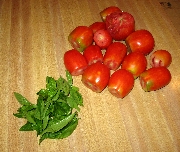
- 12 Plum Tomatoes – San Marzano or Roma
- 1 clove garlic minced
- 1 tsp extra virgin olive oil
- 15 oz can tomato sauce
- 6 leaves fresh basil
- 1/2 tsp salt
- 1/2 tsp ground black pepper
- 1 tsp dried basil
- 1 tsp dried oregano
Directions:
- Fill a large pot half way with water and bring to a boil.
- Slice the tops off tomatoes.
- Place tomatoes into boiling water being careful not to splash hot water.

- After about 3 mins check a tomato by running cold water over it. The skin should easily slide off. If not, then continue to boil another 2 mins.
- Remove tomatoes 2-3 at a time using a slotted spoon into a colander. Run under cold water and pinch off skins being careful not to squirt hot juice on yourself. Place peeled tomatoes back into colander.

- In another large sauce pot, heat olive oil and add minced garlic. Saute just until you smell the garlic – don’t brown!

- Carefully add peeled tomatoes to pot.
- Pour in tomato sauce
- Using a potato masher, carefully mash tomatoes until juice is released. No need to over mash!

- Add salt, pepper, dried basil and oregano, and basil leaves.

- Bring to a boil and then simmer for about an hour to boil off a lot of the water in order to thicken the sauce.

- You can either server the sauce immediately over pasta, etc. or let cool for about 15 mins before ladling into plastic containers. Refrigerate or freeze the sauce. If freezing, make sure that the sauce fill the container without a large air gap.

Variations:
- Instead of whole tomatoes, use a 32 oz can of crushed or whole tomatoes. Use the potato masher method if using whole tomatoes. Proceed the same way as in the instructions above.
- For super quick marina sauce, use just a can of sauce (15 oz or 8 0z) and follow the same directions. The sauce will be much thinner, but great for use over pasta or in baked dishes such as eggplant parmigiano.

Buon Appetito!
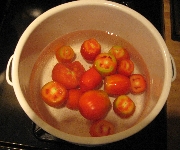
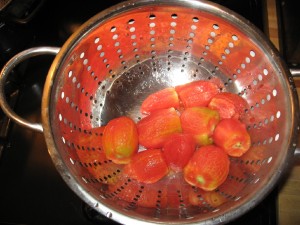
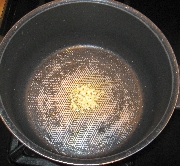
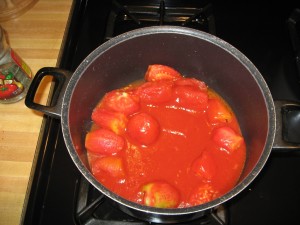
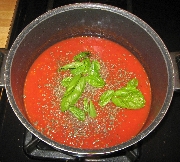
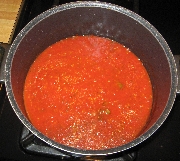
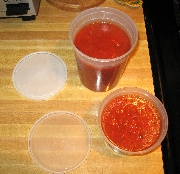
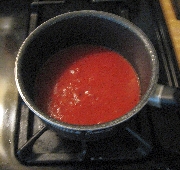



Leave a Reply